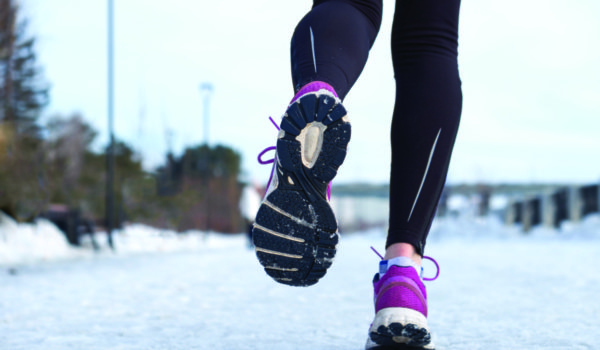
Take steps so you can keep running this winter
By Kelsey DeClue
Physical therapists often see patients that have allowed their injuries to become chronic in nature. This can occur for a variety of reasons, including weakness, tightness, improper training, avoidance of a nagging injury and poor shoe wear. Here are a few of the important factors you can control to reduce your chance of those injuries limiting your time away from running.
Among the most common running-related injuries are shin splints, stress fractions, Achilles tendonitis, hamstring injuries and plantar fasciitis. With these and most runners’ injuries, muscular balance is everything. Since muscle function and muscle balance help absorb the forces that impact the joints, muscles that work well may protect joints from excessive wear and tear.
“We often see weakness to one side of the outer hip which leads to the opposite hip dropping too much, which can cause excess hip, knee and ankle stress eventually leading to pain or injury and loss of efficiency and tolerance to running,” said Derek Whitehead, Physical Therapist and Athletic Trainer at PT Solutions.
Current research shows that gaining flexibility with performance of dynamic warm-ups is helpful with injury prevention. Winter is one of the most common times when those pre- and post-run rituals tend to take a back seat. Muscles tighten in the cold, daylight availability for runs shrinks and we tend to hydrate less. Performing dynamic stretches prior to running can help the overall muscular patterns if it is done in a manner that focuses on those muscle imbalances. Hydrating throughout the day and staying mobile help our bodies stay warm and ready for the workout ahead.
Cross-training is also a key component. It allows us to minimize those repetitive stresses that accumulate in your joints based on overtraining.
“Moving your body in a different motion than running can strengthen your muscles and smooth out imbalances,” said Whitehead. “By reducing the number of miles you run, you reduce the overall impact on your muscles, joints, and bones.”
According the Whitehead, runners can benefit most effectively from exercises that support leg and hip joints, such as squats and lunges for the quadriceps and hamstrings, calf raises and wall shin raises to support shin and ankle bones and muscles and knee hugs and stretches to support hip flexors. Of course, do not begin a new flexibility or exercise routine without first consulting a professional. A physical therapy evaluation can help determine where the body has an imbalance and prescribe the appropriate home exercise program to maximize the body’s full potential for smooth, efficient movements.
The winter is a great time to cross train and invest in an assessment of your body’s function, efficiency and areas of opportunity, by a physical therapist or athletic trainer.


